
Lilium is a genus of herbaceous flowering plants growing from bulbs, all with large prominent flowers. They are the true lilies. Lilies are a group of flowering plants which are important in culture and literature in much of the world. Most species are native to the Northern Hemisphere and their range is temperate climates and extends into the subtropics. Many other plants have "lily" in their common names, but do not belong to the same genus and are therefore not true lilies.
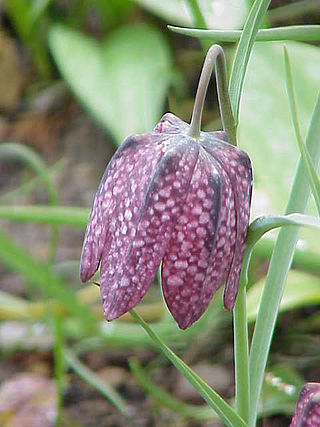
Fritillaria (fritillaries) is a genus of spring flowering herbaceous bulbous perennial plants in the lily family (Liliaceae). The type species, Fritillaria meleagris, was first described in Europe in 1571, while other species from the Middle East and Asia were also introduced to Europe at that time. The genus has about 130–140 species divided among eight subgenera. The flowers are usually solitary, nodding and bell-shaped with bulbs that have fleshy scales, resembling those of lilies. They are known for their large genome size and genetically are very closely related to lilies. They are native to the temperate regions of the Northern hemisphere, from the Mediterranean and North Africa through Eurasia and southwest Asia to western North America. Many are endangered due to enthusiastic picking.

The lily family, Liliaceae, consists of about 15 genera and 610 species of flowering plants within the order Liliales. They are monocotyledonous, perennial, herbaceous, often bulbous geophytes. Plants in this family have evolved with a fair amount of morphological diversity despite genetic similarity. Common characteristics include large flowers with parts arranged in threes: with six colored or patterned petaloid tepals arranged in two whorls, six stamens and a superior ovary. The leaves are linear in shape, with their veins usually arranged parallel to the edges, single and arranged alternating on the stem, or in a rosette at the base. Most species are grown from bulbs, although some have rhizomes. First described in 1789, the lily family became a paraphyletic "catch-all" (wastebasket) group of lilioid monocots that did not fit into other families and included a great number of genera now included in other families and in some cases in other orders. Consequently, many sources and descriptions labelled "Liliaceae" deal with the broader sense of the family.

A daylily or day lily is a flowering plant in the genus Hemerocallis, a member of the family Asphodelaceae, subfamily Hemerocallidoideae, native to Asia. Despite the common name, it is not in fact a lily. Gardening enthusiasts and horticulturists have long bred daylily species for their attractive flowers. Thousands of cultivars have been registered by local and international Hemerocallis societies. Daylilies are perennial plants, whose name alludes to its flowers, which typically last about a day.

Stephan Ladislaus Endlicher also known as Endlicher István László was an Austrian botanist, numismatist and Sinologist. He was a director of the Botanical Garden of Vienna.
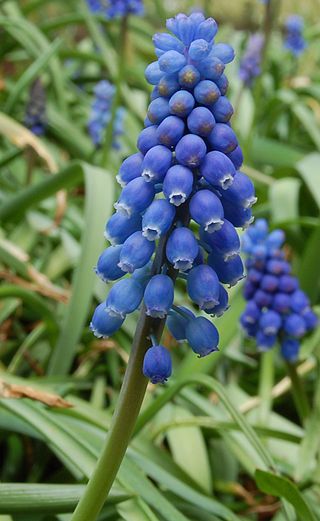
Muscari is a genus of perennial bulbous plants native to Eurasia that produce spikes of dense, most commonly blue, urn-shaped flowers resembling bunches of grapes in the spring. The common name for the genus is grape hyacinth, but they should not be confused with hyacinths. A number of species of Muscari are used as ornamental garden plants.

Lilium martagon, the martagon lily or Turk's cap lily, is a Eurasian species of lily. It has a widespread native region extending from Portugal east through Europe and Asia as far east as Mongolia.
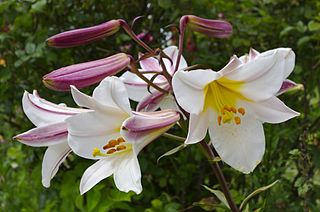
Lilium regale, called the regal lily, royal lily, king's lily, or, in New Zealand, the Christmas lily, is a species of flowering plant in the lily family Liliaceae, with trumpet-shaped flowers. It is native to the western part of Sichuan Province in southwestern China, and cultivated elsewhere as an ornamental. It was introduced to England in 1903 by Ernest Henry Wilson.
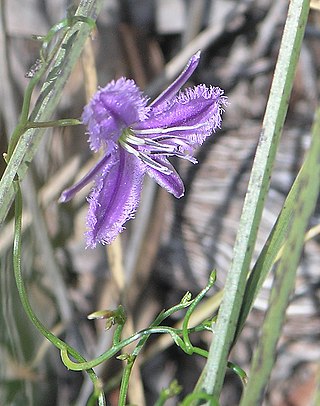
Thysanotus is a genus of perennial herbs in the family Asparagaceae, subfamily Lomandroideae. They are mostly native to Australia with 45 of the 50 known species occurring in Western Australia alone, although a few species range northward into New Guinea and Southeast Asia as far north as southern China.

Notholirion is a small Asian genus of bulbous plants in the lily family, Liliaceae. It is closely related to Lilium, but each individual flowers only once, and then dies after producing offsets. The bulb is covered by a tunic. Leaves are basal, produced in autumn and winter.

Cardiocrinum giganteum, the giant Himalayan lily, is the largest species of any of the lily plants, growing up to 3.5 metres high. It is found in the Himalayas, China and Myanmar (Burma).
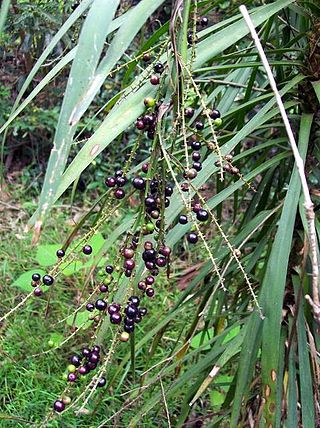
Cordyline stricta, known as the Slender Palm Lily, or Narrow-leaved Palm Lily is an evergreen Australian plant. A shrub to 5 metres tall found in wet sclerophyll forest and rainforest, usually on the coastal lowlands. From near Bilpin, New South Wales further north to Queensland. C. stricta has become naturalised in Victoria.

Amana is a small genus of flowering bulbs in the lily family, closely related to tulips and included in Tulipa by some authors. Amana is found in China, Japan and Korea. As of June 2012 the World Checklist of Selected Plant Families recognizes four species, three of which were formerly placed in the genus Tulipa:

Diurideae is a tribe of orchid in the subfamily Orchidoideae. It contains about 40 accepted genera. As of April 2018, its division into subtribes remained unclear.

The Lilioideae are a subfamily of monocotyledonous perennial, herbaceous mainly bulbous flowering plants in the lily family, Liliaceae. They are found predominantly in the temperate and colder regions of the Northern Hemisphere, particularly East Asia and North America. The subfamily includes two tribes. They are of economic importance, particularly the lilies and tulips.

The taxonomy of the plant family Liliaceae has had a complex history since its first description in the mid-eighteenth century. Originally, the Liliaceae were defined as having a "calix" (perianth) of six equal-coloured parts, six stamens, a single style, and a superior, three-chambered (trilocular) ovary turning into a capsule fruit at maturity. The taxonomic circumscription of the family Liliaceae progressively expanded until it became the largest plant family and also extremely diverse, being somewhat arbitrarily defined as all species of plants with six tepals and a superior ovary. It eventually came to encompass about 300 genera and 4,500 species, and was thus a "catch-all" and hence paraphyletic. Only since the more modern taxonomic systems developed by the Angiosperm Phylogeny Group (APG) and based on phylogenetic principles, has it been possible to identify the many separate taxonomic groupings within the original family and redistribute them, leaving a relatively small core as the modern family Liliaceae, with fifteen genera and 600 species.

Fritillaria raddeana is a perennial herbaceous bulbous plant, distributed in Iran, Turkmenistan and Kashmir. It is a species in the genus Fritillaria, in the lily family Liliaceae. It is placed in the subgenus Petilium. Resembling Fritillaria imperialis, but shorter, it is sometimes referred to as the dwarf crown imperial.
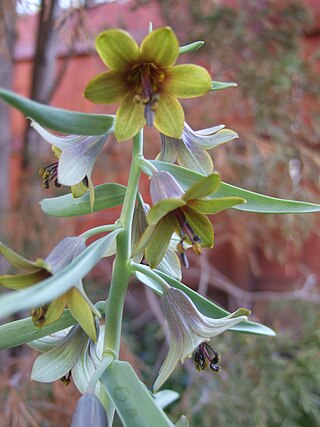
Fritillaria sewerzowii is a perennial herbaceous bulbous plant, distributed in alpine areas of central Asia. It is a species in the genus Fritillaria, in the lily family Liliaceae. It is placed in the subgenus Korolkowia.
Lilium sherriffiae is a species of Lilium native to Bhutan and Nepal in southeastern Asia.



















